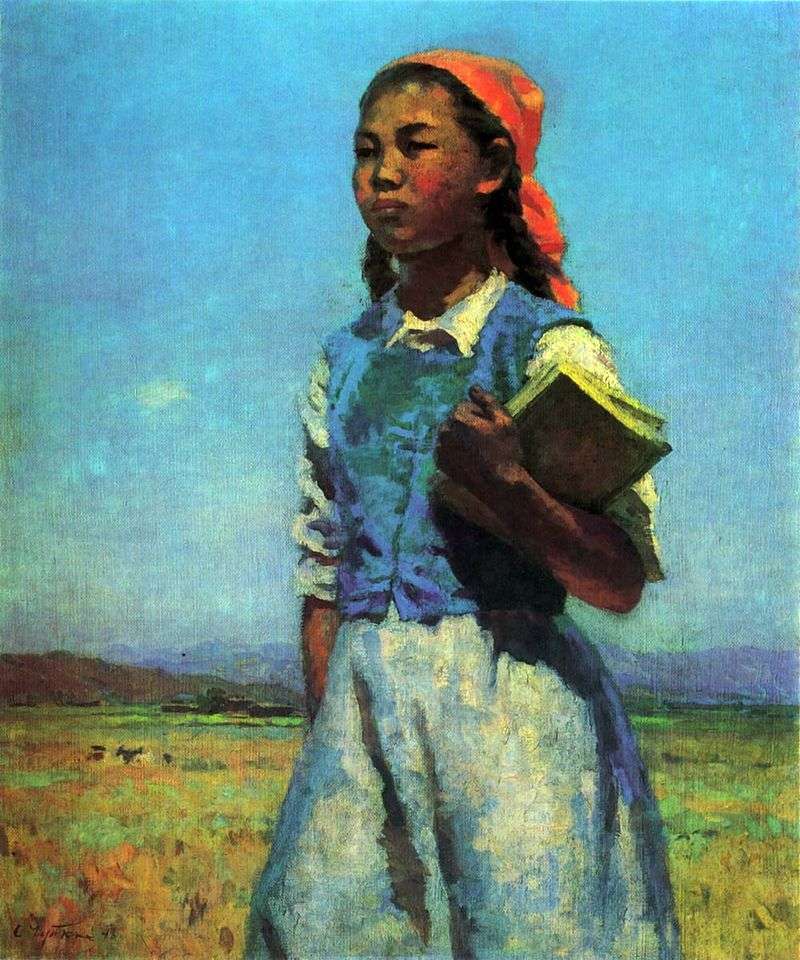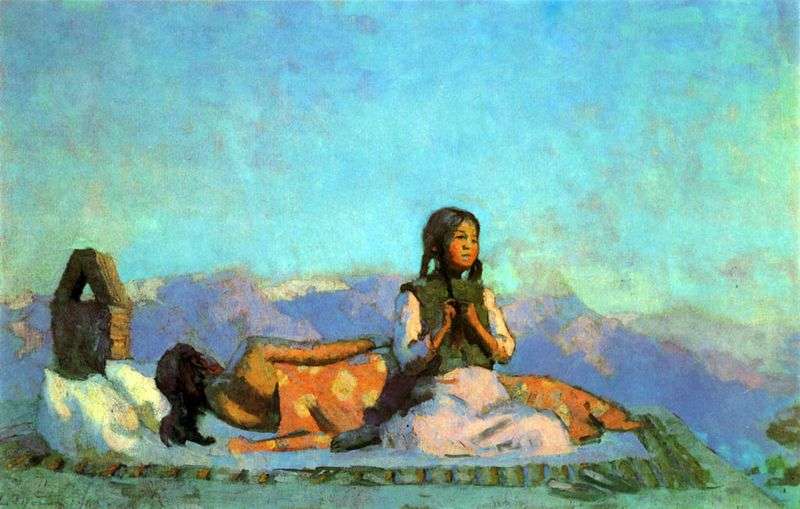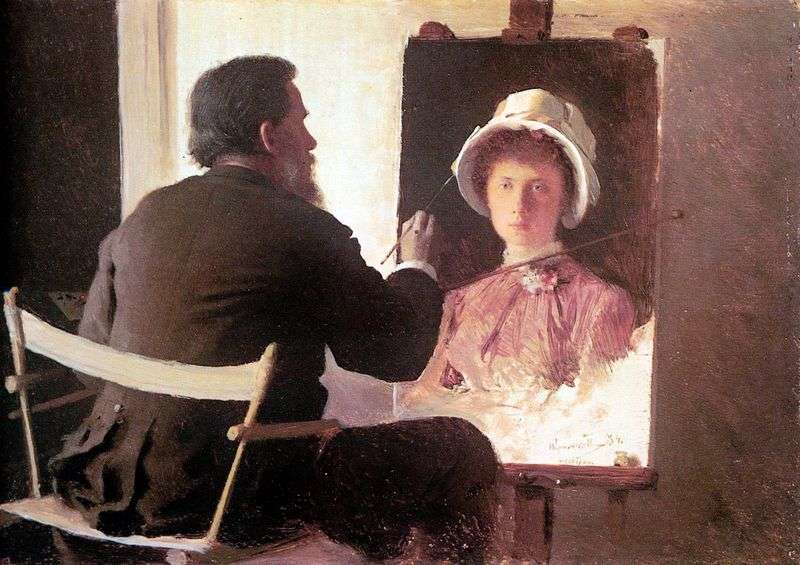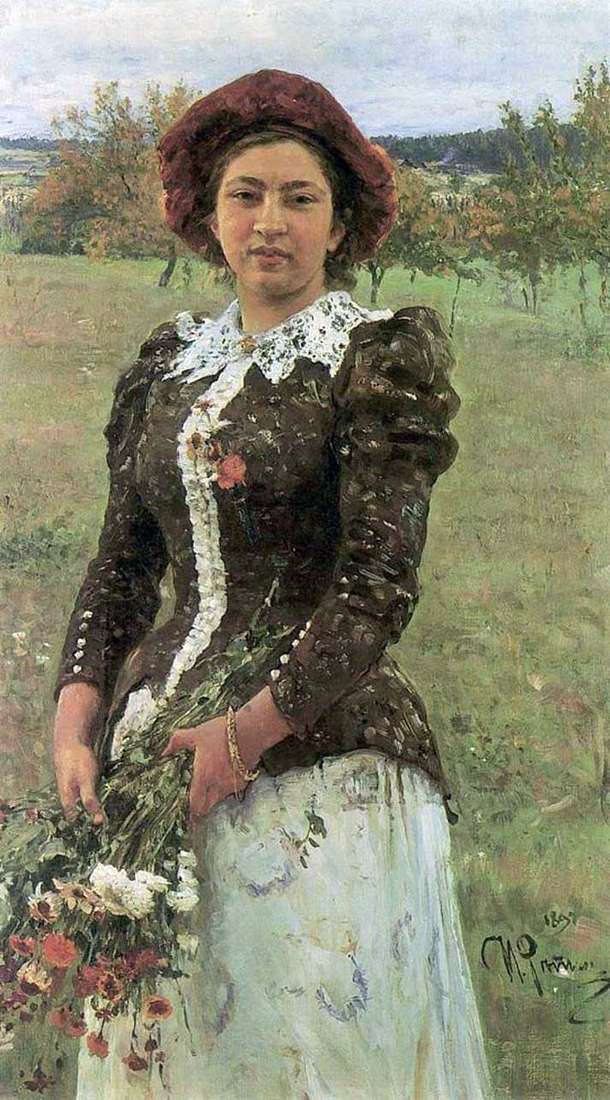
The daughter of Soviet Kirghizia [1948] In an effort to create a generalized image, the artist builds a composition on the monumental proportions of large forms. A slightly lower horizon makes it possible to show the girl’s figure almost entirely against the sky. And because the viewer looks at the picture as if from below, a fragile, delicate figure acquires a special weight, monumentality, significance. This is enhanced by a strict, very solid silhouette, clearly drawn on a smooth background of the clear sky.
Chuikov does not endow his heroine with external signs of excitement, romantic elevation. The viewer does not see spectacular gestures here. On the contrary, the artist builds an image on restraint, strict simplicity, inner concentration. Kirghiz girls often amaze with refined eastern beauty. But here the artist does not yield to the temptation to admire, to attract the viewer with the natural beauty of the facial features. The face of the heroine is round, boring, with a deep-set eyes, the most ordinary, what thousands you will find in the auls and camps of the Kyrgyz region. But in this person the work of thought is clearly perceptible, but tightly compressed, unsmiling lips, a firm, direct look give out a character purposeful and integral. Smoothly combed hair opens a high clean forehead.
Such a quiet dignity can be borne only by a person who has acquired the right to freely choose the path of his life. The eye of an outside observer would not have been possible in everyday, everyday to discover these features of a new national character. It was necessary to observe the life of the people step by step, to see how the image of a new person crystallizes gradually, so that it can be expressed with such force of convincing in a picturesque work. Chuikov himself, along with the Kirghiz people, went through this difficult path – from awakening to the first steps of an independent free life. He was born in Kyrgyzstan. As a boy, wandering around with a homemade plywood box with paints along the mountains of Kyrgyzstan, he observed the life of the Kyrgyz poor. “The tattered yurt, smeared with smoke of numerous nomadic things,” recalls the artist, “it seemed, consisted of some patches, and yet the holes in them were even greater. Nighting in them, I, I remember, could easily see the starry sky through a hollow felt. The inhabitants of these yurts themselves were also torn, smoked and charred from the smoke of fires and sunny heat, as their dwellings, like the land around them. The naked children almost merged in color with the earth and felt. “
Wearing these memories of childhood in my heart, Chuikov noticed with special sharpness those joyful changes in the life of the people that were being accomplished before his eyes. It is enough to put these lines next to the picture “The Daughter of Soviet Kirghizia” in order to feel what enthusiasm the artist possessed when he created this work of his own. As a rule, the detailed work on the canvas by Chuikov is always preceded by a detailed development of the concept in sketches and sketches. But to the “Daughter of Soviet Kirghizia” there was almost no preliminary and etude material. And this is by no means an accident. Gradually, from year to year, the artist went to create this generalized, typical image. And many of his finished works, such as “The Girl with Cotton”, “The Girl with the Sunflower”, “The Girl with the Book”, ” – these are certain milestones in the way of creating the image of “The Daughter of Soviet Kirghizia.” In each of them live features that are collected, brought together in this picture. It is interesting that the artist often translates individual images from one of his paintings to another. But Chuikov is never limited to a mere repetition of what he once found: from painting to painting, the artist grinds, sharpens the character, makes it deeper, more versatile.
So, in “Polonda” we meet almost with the same girl as in the picture “A Girl with a Watermelon”. There is much in common in the appearance, the character, even the composition motif and between “The Girl with the Watermelon”, “The Girl with the Book” and “The Daughter of the Soviet Kirghizia”. But if in the first two lines of character disclosure in all its depth are only outlined, and the work itself is of a somewhat etude character, then in the last one the image is completed, all that is accidental is discarded, which would prevent the monumental sound of the picture. To this top of his work the artist came up for many years. This is why the most characteristic features of the artistic outlook, Chuikov’s creative method, were manifested with such force. Inseparably connected with the nature of the idea and the color scheme, the picturesque manner of Chuikov.
The contrast ratio of the three primary colors of the painting – blue, red and white – gives rise to a feeling of cheerfulness, joy. Lilac, silver and mother-of-pearl colors create the richest scale in the canvas. The black-and-white transitions are solved unusually picturesquely. The artist seeks to ensure that colors are combined in a harmonious sound. Harmonize, merge in a single tonality such bright colors as white, blue, red, brown, helps the overall warm tone: the scene is as if wrapped in a heat shivering from the heat, and this light haze softens the outlines, mutes the voiced colors. According to the strength and significance of the image, according to emotional saturation, poetic emotion, and the bright picturesque wealth, “Daughter of Soviet Kirghizia” should be attributed not only to the best works of the author. She rightfully enters the gold fund of Soviet painting.
 Morning in a mountain village by Semyon Chuikov
Morning in a mountain village by Semyon Chuikov Kramskoy, writing a portrait of her daughter by Ivan Kramskoy
Kramskoy, writing a portrait of her daughter by Ivan Kramskoy Portrait of the oldest Soviet artists I. Pavlov, V. Baksheev, V. Byalynitsky-Biruli and V. Meshkov by Alexander Gerasimov
Portrait of the oldest Soviet artists I. Pavlov, V. Baksheev, V. Byalynitsky-Biruli and V. Meshkov by Alexander Gerasimov Eugene Manet with her daughter in Bougival by Berthe Morisot
Eugene Manet with her daughter in Bougival by Berthe Morisot Lot and his daughter by Albrecht Altdorfer
Lot and his daughter by Albrecht Altdorfer Resurrection of the daughter of Jairus by Ilya Repin
Resurrection of the daughter of Jairus by Ilya Repin Autumn Bouquet (Daughter Vera) by Ilya Repin
Autumn Bouquet (Daughter Vera) by Ilya Repin Sleeping Girl by Roy Lichtenstein
Sleeping Girl by Roy Lichtenstein